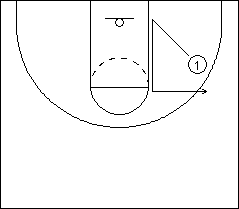A very interesting discussion thread on the X's and O's thread about whether or not you should teach the v-cut or not. A good description of the v-cut can be found on Hoop Thoughts, a blog run by LSU Women's coach Bob Starkey, which I've partially reproduced below:
Once we get into the scrimmage area with our offense, there will be nothing that we do as far as movement that will not begin with a V-Cut. It is our base cut for all that we do in terms of setting up our cuts and screens. The ability to incorporate the v-cut into our offense again lends support to being hard to guard. It is a maneuver that keeps the defense from easily anticipating our final cutting direction – especially since it is the positioning of the defender that tells us which way to start our v-cut. For instance, if the defender is below the cutter as shown in Diagram #1, the offensive player will start the v-cut by also going low. We want to start all of our cuts with a two-step set-up. The two-step set-up should be a slower movement as opposed to a full sprint. In fact, our terminology for the movement of the two-step set-up is referred to as “walking your defender down.” The offensive player, after taking two steps towards the baseline, will then plant the outside foot and accelerate into the cut. The final part of the cut should be a sprint towards the basketball to shorten the pass. The obvious reason for the change of speed is it is still yet another area in which we keep the defender off balance and stay hard to guard.

Arguments Against the V-cut:
Having explained the v-cut above, the issue that comes up most often with the v-cut is that it can lead to turnovers, especially if the passer and cutter are not in sync. The other issue of course is if the defense is playing a very aggressively on the line, the wing player ends up "foot fighting" -- trying to get over the top of the defender's top foot.
Now, in some offensive systems, the v-cut does not figure prominently. For example, in the read and react, if the defense is overplaying on the 3-point line, the read is always backdoor no matter what.
Alternatives to the V-cut:
There are a couple of alternatives to the straight v-cut. Some teach a L-cut or a triangle cut,

Others teach an arm-bar, seal, pin and pop. The picture I found below is just a post-up, but its basically the same principle, pin the defender, then you can pop out for the pass,

Should You Still Teach the V-Cut:
Before answering the question, I think it's important to understand what all these cuts accomplish. The v-cut is good for establishing movement without the basketball. If you run true motion, then there is no way around the v-cut, as Coach Starkey points up above, the v-cut is the basis of all their movement. In a Read and React or DDM, the v-cut is almost irrelevant.
However, having said that, as a fundamental skill, I think the v-cut still needs to be taught. It's all part of that intangible we call Basketball IQ. Because as a coach of JV and under, you don't know what your players will run in as they move up to Varsity or college. You don't want your players to get into a situation where their future head coach in Varsity or college says: "What's wrong with you Johnny, why can't you v-cut properly, we run it every time in motion!!" and Johnny says: "Coach, what's a v-cut??"
If you're looking for more info on getting open then take a look at the Five-star Basketball DVD on getting open and attacking. Coach Bergeron goes through all the basics of cutting.

John
July 14, 2009 at 4:09 AM
The triangle cut seems to be quite an inefficient and potentially risky move. Similar to the V-cut, but on the movement away from the foul line towards the three point line you leave an avenue for the opponent to get back in the play and steal the ball if he is lagging behind on the chase. The ground he's required to cover to steal the ball is less than that required to get free and receive the pass. I teach the v-cut and l-cut, but prefer players to use the seal and pop. Gets players to get a feel of their defender and helps in post-up situations as well.